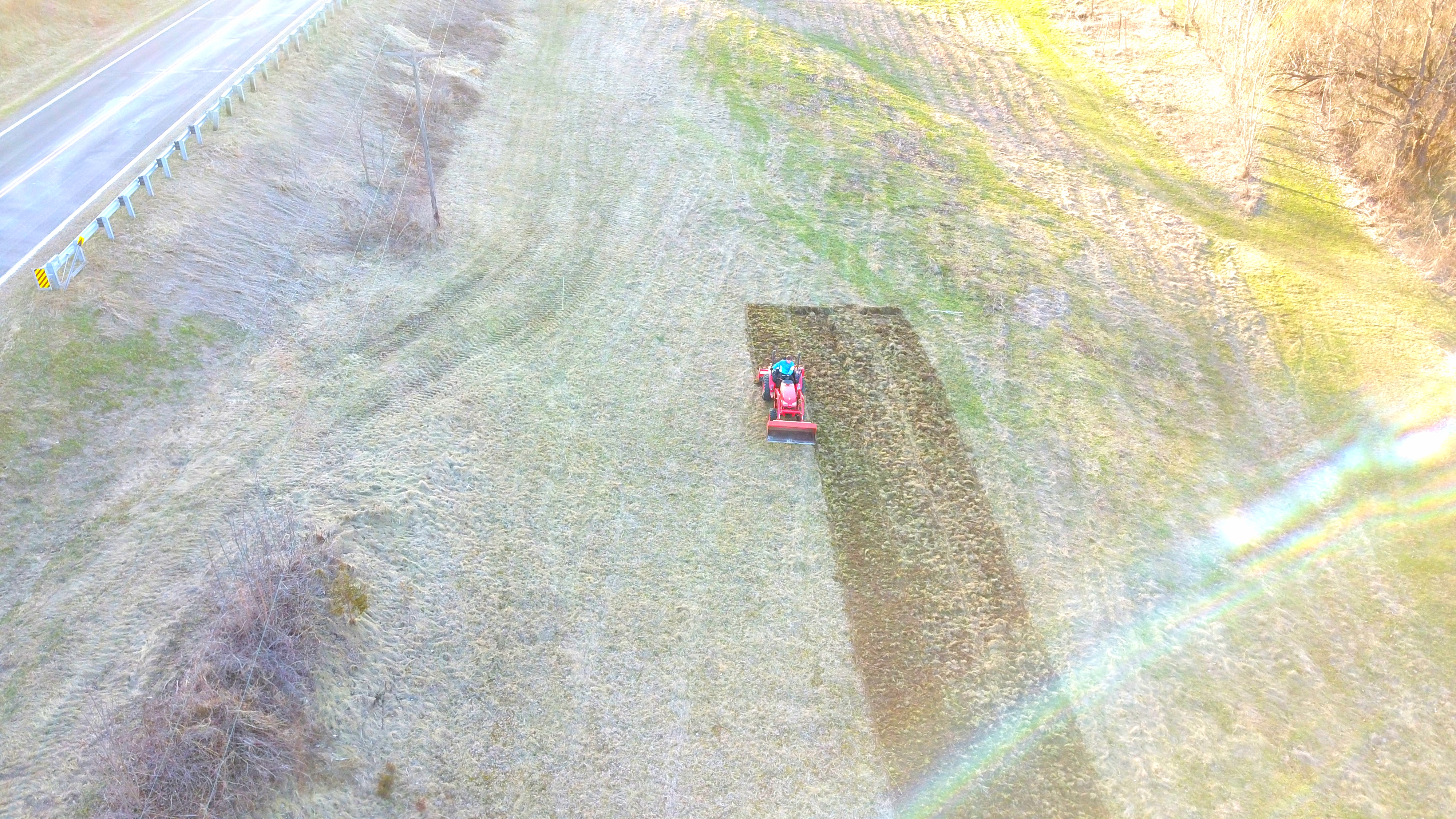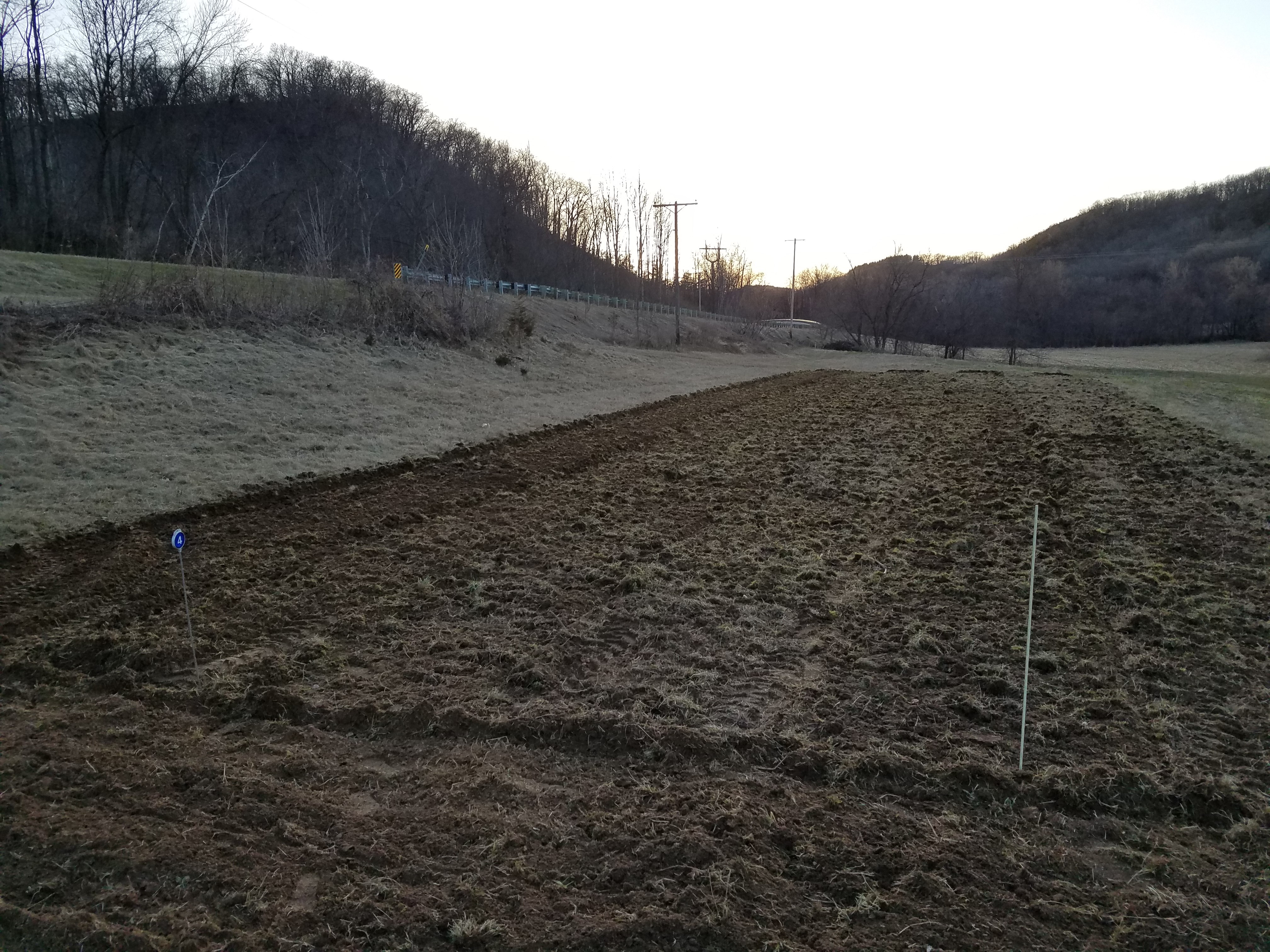Saturday morning, I raced the Ken Woods Road Race, with my sister, riding 84 miles in an hour and half, about twice as long as any other ride I have done this year.
Despite my complete exhaustion, when we got to our family’s farm in southeastern Minnesota later in the day, I began a project which I have been preparing for some time.
Background:
Some ten years ago, my dad decided he wanted the field west of the barn to be level, I believe with the intention of having a nice shooting range for air rifle. Originally, the field had been used for pasture, and was quite fertile. However, the leveling removed the topsoil from most of the top part of the field. Now, there is a jungle where all the top soil was pushed, and a barren wasteland where only clay subsoil remains.

Kelly rototillering the test area while I chase her with the drone. Note the difference here, even in early spring, in color between the top clay subsoil (left) and lusher topsoil (right). Shot in d-log color style without any post editing, hence the flat whitish color of the photo.
Despite ten years to recover, the top part of the field is still, well, pathetic. It’s dominated in late summer by Queen Anne’s Lace blossoms, but is mostly an uneven mix of patchy grass.
I, inspired by Landscaping with Native Plants of Minnesota 2nd edition, decided a dose of native biodiversity was the key to renovating this field, and providing more habitat for native pollinators and forage for my bees as well.
My thought process behind this experiment was that current soil, while having a very weedy seedbank, given it’s current struggles, wasn’t going to seriously out-compete the new seedmix. But I’m not sure. Nor was I sure about the benefits/harm of tilling, and with the possibility of converting more of the field into prairie in the future, I wanted to see what the best way to prepare was.
Question:
What form of site preparation is best?
Treatments here:
- 1 pass tilling with herbicide before and after tilling
- 1 pass tilling (1 pass tilling leaves large chunks of soil unbroken)
- 2 pass tilling
- 3 pass tilling (soil up to garden levels, loose in so far as clay can be)
- Control -remaining portions of original clay subsoil, undisturbed
- 500 sq ft of “Pollinator-Palooza Mix” in better soil downfield (1 pass till)
I am expecting 1 pass tilling without herbicide to be the best method, with the soil only partially disturbed (enough to plant in, but much of the extant grass will recover, and the deeper seed-bank is only partially disturbed). One pass tilling also reduces the dangers of erosion. Given more room, I would also have liked to have done a 3 pass tilling with herbicide, to be thorough, although 3 pass tilling generally eradicates all sprouted, extant weeds
Materials:
- ~7000 sq. ft of clay subsoil field
- Tallgrass Exposed Clay Subsoil Mix from Prairie Moon Nursery (Winona, MN)
- 1/8 acre mix size. Note this means I was slightly underseeding
- Dominant species by weight: partridge pea, coneflowers, prairie clovers, etc.
- Major grasses: big bluestem, Canadian and Virginian wild rye, Indian grass
- Tractor, rotortiller, rakes
- Herbicide (generic brand Glyphosate)
- Leftover flower seeds (sunflowers, asters, lavender) from previous years
Process:
In late January I began cold stratifying the forbe (aka non-grass) seeds in vermiculite in our refrigerator. Because of our unexpectedly late spring, with blizzards in mid-April, some of the seeds had already begun to sprout.
Rotortilled field on the evening of April 28th. The next morning, the field was planted according to Prairie Moon instructions. A slight variation was made in that I presoaked about a third of the grass and oat groundcover seed in warm water for a few hours, to encourage them to get started. The broadcast seeder didn’t like spreading the grass seeds, so all seed was broadcast by hand. This means that the distribution of seeds won’t be perfectly even across the field.

Tilled field. Treatments are, left to right, Tilling 3 pass, Tilling 2 pass, Tilling 1 pass, Tilling 1 pass with herbicide. The multiple pass tilling sections were only one strip each. The 3 pass section on the far left stands out as a darker color, and is clearly finer in appearance.
The field was not watered immediately. I was counting on it getting rained on by the passing showers forecast for the next week.
Now it is time to wait and see… There are no maintenance plans for the site for the next year. Maybe some mowing, maybe watering, but probably not either unless it seems critical to do so.
